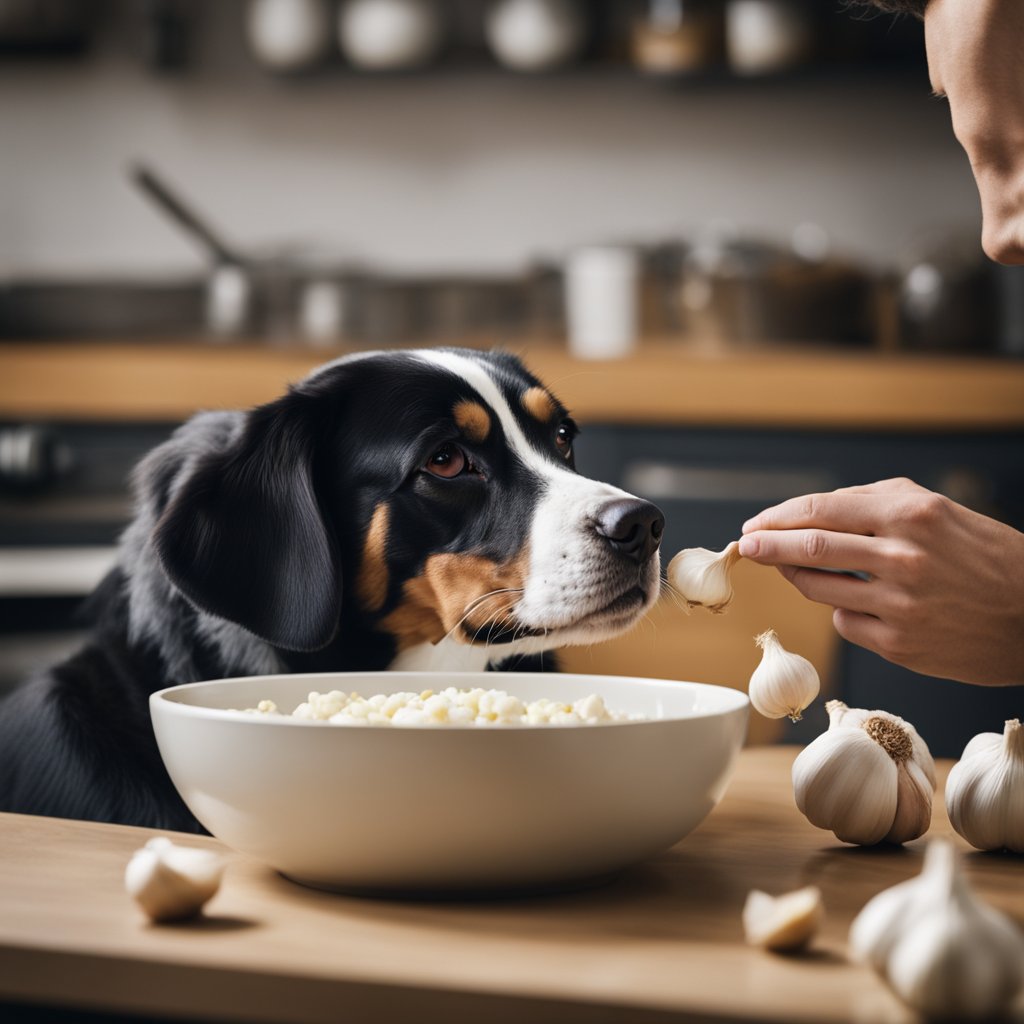Can Dogs Have Garlic? Understanding the Risks and Benefits
Many dog owners wonder about adding garlic to their pet’s diet. While garlic is often praised for its health benefits for humans, it is not safe for dogs and can be toxic, leading to serious health issues. Understanding what foods are safe for your furry friend is crucial in keeping them healthy and happy.

Instead of enhancing your dog’s meals with garlic, it’s important to know the risks it poses. Common symptoms of garlic toxicity include anemia and gastrointestinal distress. You should always consult your veterinarian before introducing new foods into your dog’s diet to avoid any harmful effects.
Key Takeaways
- Garlic is toxic to dogs and should be avoided.
- Signs of garlic toxicity include vomiting and lethargy.
- Always check with a vet before giving new foods to your dog.
Risks of Garlic to Dogs

Garlic poses certain risks to dogs, especially when consumed in significant amounts. Understanding how garlic affects your dog’s health is essential for responsible pet ownership.
Toxicity Explained
Garlic contains compounds that can be harmful to dogs. The primary concern is thiosulfate, which can trigger oxidative damage to red blood cells. This damage may lead to hemolytic anemia. Research indicates that it takes about 15 to 30 grams of garlic per kilogram of your dog’s body weight to cause serious health issues. This means a small amount, especially for small dogs, can still be problematic. For instance, a 50-pound dog could be affected by just about four cloves.
Clinical Symptoms
If your dog ingests garlic, they may show various symptoms. Common signs include:
- Vomiting
- Diarrhea
- Abdominal pain
- Lethargy
- Pale gums
These symptoms may not appear immediately, and it could take days for them to develop. If you notice any of these symptoms after your dog consumes garlic, it’s important to consult your veterinarian promptly.
Potential Long-Term Health Issues
Repeated exposure to garlic can lead to long-term health issues. Chronic consumption, even in small amounts, might result in ongoing anemia. This condition reduces your dog’s ability to carry oxygen in their blood, causing fatigue and weakness. Additionally, long-term oxidative damage can lead to more severe health problems affecting vital organs. Staying aware of what your dog eats will help you avoid these risks, ensuring a healthier and happier life for your pet.
Prevention and Treatment

Being proactive can help protect your dog from the risks of garlic. Understanding what to do in case of exposure is essential. Here are the key aspects to keep in mind.
Preventive Measures
To prevent garlic toxicity, be vigilant about your dog’s diet. Avoid giving them any foods containing garlic, including sauces, seasonings, and processed snacks.
When cooking, keep garlic and garlic-laden foods out of your pet’s reach. Train your dog to avoid begging for table scraps, which may contain harmful ingredients.
It’s critical to read ingredient labels on pet food carefully. Some products might contain garlic as a flavor enhancer. If you’re unsure about a food item, consult your vet for safe options.
First Aid Response
If you suspect your dog has eaten garlic, take action right away. Assess the amount consumed and note the time. If it’s a small amount, you might be able to monitor your dog at home.
Keep an eye out for signs of garlic poisoning, such as vomiting, diarrhea, or weakness. If any symptoms arise, do not wait.
You can try to induce vomiting if the ingestion occurred within the last two hours. Use peroxide solution, but only after confirming the correct dosage with your veterinarian.
Veterinary Interventions
If your dog shows severe symptoms or if you know they consumed a significant amount of garlic, contact your vet immediately. Treatment can involve various steps tailored to your dog’s condition.
The vet may perform tests to determine the level of toxicity. They could recommend supportive care, including IV fluids, to help flush out toxins.
In severe cases, blood transfusions might be necessary if there is significant organ damage. Your vet will guide you on the best treatment plan depending on your dog’s specific needs.
Resources

If you’re curious about garlic and dogs, there are several reliable resources you can explore for more information.
- American Kennel Club: They provide insights on why garlic is not safe for dogs. You can read more about it here.
- Volhard Dog Nutrition: This site discusses myths about garlic toxicity and offers useful study data. Check it out here.
- Canine Journal: This resource outlines the risks of garlic consumption in dogs and gives an overview of safe practices. You can find more information here.
- Purina: Learn about the risks associated with garlic and potential reactions in dogs. Visit their article here.
- Dogster: This site shares expert-reviewed advice on dog nutrition, including information on garlic. Read their insights here.
These resources can help you make informed decisions about your dog’s diet and safety. Always consult your veterinarian if you have concerns about your pet’s health.
Frequently Asked Questions

Garlic can pose serious health risks to dogs, and it’s important to be informed if you suspect your pet has ingested it. Understanding the symptoms, levels of toxicity, and the appropriate actions to take can help ensure your dog’s safety.
What are the symptoms of garlic poisoning in dogs?
Symptoms of garlic poisoning may include vomiting, diarrhea, weakness, and lethargy. You might also notice pale gums, an increased heart rate, or a lack of appetite. These symptoms can appear a few days after ingestion, so monitoring your dog is crucial.
How much garlic is toxic to dogs?
The toxic dose of garlic can vary by the dog’s size, but generally, even small amounts can be harmful. For a 50-pound dog, toxicity can occur with about 1.2 grams of garlic daily, equal to roughly half a clove. Smaller dogs are at higher risk from even lesser amounts.
Are there any benefits to giving dogs garlic?
While some claim that garlic has health benefits, it is not safe to give dogs garlic regularly. Some dog foods contain trace amounts of garlic for flavor, which may not be harmful. However, you should not intentionally add garlic to your dog’s diet.
What immediate steps should be taken if a dog ingests garlic?
If your dog ingests garlic, contact your veterinarian right away. They may recommend inducing vomiting if the ingestion was recent. Always provide details about the amount and type of garlic consumed for more tailored advice.
Can ingestion of garlic bread lead to health issues in dogs?
Yes, garlic bread can be particularly harmful due to its high garlic content and other ingredients like butter and onion. These can worsen the effects of garlic and create additional health risks. It’s best to keep all garlic-flavored foods away from your dog.
Is there a difference in toxicity between raw and cooked garlic for dogs?
Both raw and cooked garlic are toxic to dogs, but raw garlic is generally considered more potent. Cooking may reduce some of its harmful compounds, but it’s still unsafe for dogs. It’s best to avoid giving them any form of garlic to be safe.

